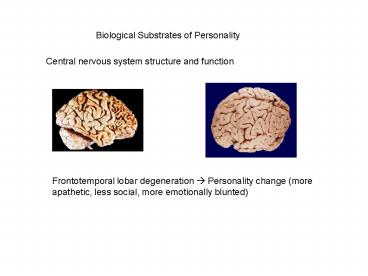Biological Substrates of Personality - PowerPoint PPT Presentation
1 / 24
Title:
Biological Substrates of Personality
Description:
Examples: Prozac (fluoxetine, 1988); Serzone (1990), Celexa (1991) ... to Prozac (Kramer, ... unchronicled reason for Prozac's enormous popularity: its ability ... – PowerPoint PPT presentation
Number of Views:58
Avg rating:3.0/5.0
Title: Biological Substrates of Personality
1
Biological Substrates of Personality
Central nervous system structure and function
Frontotemporal lobar degeneration ? Personality
change (more apathetic, less social, more
emotionally blunted)
2
Eysenck Returns Extraversion
Central nervous system structure and function
Ascending reticular activation system regulates
arousal, wakefulness Baseline arousal
environmental arousal total arousal
3
Eysenck Returns Extraversion
Ascending reticular activation system regulates
arousal, wakefulness Baseline arousal
environmental arousal total arousal
4
Biological Substrates of Personality
Autonomic nervous system
Sympathetic and parasympathetic branches
5
Eysenck Returns Extraversion
Ascending reticular activation system regulates
arousal, wakefulness Baseline arousal
environmental arousal total arousal Baseline
arousal determines environmental choices to
regulate total arousal
(From Geen, 1984)
6
Eysenck Returns Neuroticism
Central nervous system structure and function
Limbic system (hippocampus, amygdala, septum,
prefrontal cortex, and others) is the seat of the
emotions
7
BIS and BAS
Central nervous system structure and function
Behavioral approach system (BAS) is thought to be
mediated by the basal ganglia, which can
disinhibit other structures Reward-seeking Beha
vioral inhibition system (BIS) is thought to be
mediated by the frontal cortex and limbic
system Punishment-avoiding
8
BIS and BAS
Central nervous system structure and function
Behavioral approach system (BAS) is also
associated with greater left than right
hemispheric activation in the frontal
lobes Reward-seeking Behavioral inhibition
system (BIS) is, conversely, associated with
greater right than left hemispheric
activation Punishment-avoiding
9
Biological Substrates of Personality
Transmitter systems
Major brain transmitters serotonin (5HT),
norepinephrine (NE), dopamine (DO). Systems are
affected by production, reception, and
potentiation.
10
Transmitter systems
Can drugs that affect neurotransmitters affect
personality? Selective serotonin reuptake
inhibitors Examples Prozac (fluoxetine, 1988)
Serzone (1990), Celexa (1991), Paxil (1992),
Zoloft (1993), Luvox (1994), Remeron (2001), and
so on
Number of US prescriptions per year
11
Transmitter systems
Listening to Prozac (Kramer, 1997)
Tess eldest of 10 children from impoverished,
abusive background history of maternal
depression married at 17 to abusive, alcoholic
husband and later divorced multiple symptoms of
major depressive disorder treated with Prozac
for 2 weeks
I believe Tesss story contains an unchronicled
reason for Prozacs enormous popularity its
ability to alter personality. Here was a patient
whose usual method of functioning changed
dramatically. She became socially capable, no
longer a wallflower but a social butterfly.
Where once she had focused on obligations to
others, now she was vivacious and fun-loving.
Before, she had pined after men now she dated
them, enjoyed them, weighed their faults and
virtues. Newly confident, Tess had no need to
romanticize or indulge mens shortcomings.
12
Transmitter systems
Listening to Prozac (Kramer, 1997)
Tess eldest of 10 children from impoverished,
abusive background history of maternal
depression married at 17 to abusive, alcoholic
husband and later divorced multiple symptoms of
major depressive disorder treated with Prozac
for 2 weeks
13
Transmitter systems
Selective Alteration of Personality and Social
Behavior by Serotonergic Intervention (Knutson
et al., 1998, American Journal of Psychiatry)
Affiliation suggestions vs. commands, grasps in
a cooperative puzzle task
14
Temperament
Defining characteristics in common with a general
definition of personality individual
difference stable Defining characteristics
specific to temperament partially
heritable neurophysiological underpinnings present
during early life
15
Temperament
Inhibited temperament (Jerome Kagan)
Defining characteristics in common with a general
definition of personality individual
difference inhibited children (15-20) are shy,
timid, fearful, restrained uninhibited children
(20-25) are bold, spontaneous, fearless stable
infant tests predict play styles in
childhood Defining characteristics specific to
temperament partially heritable boys MZ r
.64, DZ r .25 girls MZ r .45, DZ r
.22 neurophysiological underpinnings SNS
arousability present during early life evident
as early as 4 months of age
16
Temperament
Other kinds of temperament (Buss and Plomin,
others)
activity energy, physical movement,
squirming positive emotionality/sociability
enjoy interactions with others negative
emotionality easily upset, fussing,
crying impulsivity/distractability less
careful and thoughtful, easily distractable appro
ach-withdrawal similar to BIS/BAS
17
Sex differences Personality of 313
Women Agreeable Empathetic Trusting Extraverted
Anxious Men Aggressive Assertive No
difference Impulsive Orderly Open Reflective
18
(No Transcript)
19
(No Transcript)
20
Sex differences Hormonal systems
testes ovaries adrenal gland
21
5ARD (5-alpha-reductase deficiency) Converts T
to DHT DTH is necessary for development of male
external genitalia. Virilisation may occur at
puberty. Huevo a los doces (Dominican
Republic) Autosomal recessive inheritance
22
Sex differences Hormonal systems
Children congenital adrenal hyperplasia and
prenatal exposure to androgens
Men correlations between T and crime,
education, profession, and marriage
Women study of 87 maximum-security inmates
(aged 17-60) T 1 2 3 1.
age -.43 2. criminal violence .18 .05 (t
heft vs. self-defense vs. homicide, assault) 3.
aggressive dominance .34 -.25 -.25 (trouble,
aggression, domination, violations)
23
Sex differences Evolution and mating strategies
Issue Females Males Reproductive
constraints A limited number of children No
constraints on reproduction Optimal
strategy Best quality mate Largest number of
mates Desired mate quality Resources,
fidelity Childbearing capacity,
promiscuity Indications of quality Earning
capacity, status, Physical attractiveness,
health, possessions, generosity, youth ambit
ion Most likely basis for jealousy Sexual
infidelity with other Emotional attachment to
other by partner (certainty of
paternity) (certainty of resources)
24
Sex differences Evolution and mating strategies































